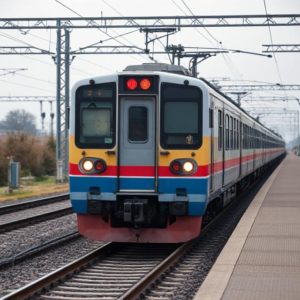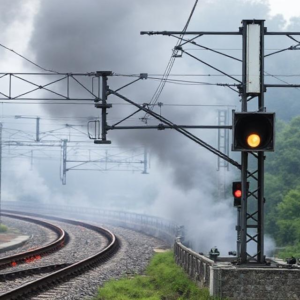Mobile Communication Networks in Railways are systems that allow trains, stations, and control centers to communicate with each other using mobile (cellular) networks. These networks help keep everything running smoothly by allowing for fast data transfer, voice communication, and real-time updates between the trains, stations, and control centers. Let me break it down in a simple way:
1. What are Mobile Communication Networks in Railways?
- Mobile communication networks use cellular signals (like the ones your mobile phone uses) to transmit voice, data, and video. These networks allow trains to stay connected to control centers, stations, and passengers as they move along the tracks.
- Unlike traditional wired communication systems, which rely on cables or fixed infrastructure, mobile networks use wireless technology, making it easier to communicate over large and moving distances (such as on a train).

2. How Do Mobile Communication Networks Work in Railways?
Mobile communication in railways works by setting up a network of mobile towers or base stations along the tracks. The key components include:
- Base Stations: These are like the cell towers you see for mobile networks. They are placed along the railway tracks to provide coverage. When a train moves, it connects to the nearest base station, which allows it to send and receive data.
- Train Communication Equipment: Trains are equipped with onboard mobile communication systems (like routers or antennas) that connect to these base stations. These systems handle the data, voice, and internet communication between the train and the rest of the railway system.
- Railway Control Centers: These centers monitor train movements, track schedules, and manage operations. Mobile networks connect control centers with trains, allowing them to send commands and receive information like speed, location, and status of the train.
- Mobile Data Services: Trains can send real-time data (like train location, speed, and technical status) to the control center, while passengers can also use mobile networks to access internet services, track train schedules, or get updates on delays.
3. Why Are Mobile Communication Networks Important for Railways?
- Real-Time Communication: Mobile networks allow constant communication between trains, stations, and control centers. This is crucial for safety (avoiding accidents), coordination (managing train schedules), and efficiency (ensuring smooth operations).
- Safety: Mobile communication networks enable quick and efficient communication during emergencies. If there is an incident, like a train breakdown, the train can immediately send a distress signal to the control center. This helps the control center respond quickly and alert other trains if needed.
- Passenger Services: Mobile networks enable Wi-Fi and real-time updates for passengers. Passengers can get updates on train schedules, delays, and track conditions via apps or onboard systems. They can also use their phones for internet access during the journey.
- Efficient Train Management: Mobile communication systems allow train operators to monitor the status of trains on the move. This helps in adjusting schedules, preventing delays, and optimizing the flow of traffic on busy routes.
4. Key Benefits of Mobile Communication Networks in Railways:
- Wide Coverage: Mobile communication networks can cover large areas, including remote or hard-to-reach locations, where traditional cable-based systems might not be feasible.
- Flexibility: Mobile networks are wireless, which means they can easily adapt to changing environments (like trains moving at high speeds). They also help manage train movements in places with tunnels, curves, or densely populated areas where fixed communications systems might struggle.
- Improved Coordination: With continuous communication between trains and control centers, railway operators can coordinate train movements more effectively, reduce the risk of accidents, and adjust routes if necessary.
- Passenger Connectivity: Passengers can enjoy internet access on the train, allowing them to stay connected, work, or entertain themselves during their journey. Mobile communication also helps provide up-to-date information on train schedules and station announcements.
- Cost-Effective: Setting up a mobile network is often cheaper than installing complex wired infrastructure over long distances or in difficult-to-reach areas. This makes mobile communication a cost-effective choice for railways.
5. Types of Mobile Networks Used in Railways:
- 2G, 3G, 4G, and 5G Networks:
- 2G (GSM): This was one of the early mobile technologies used for basic voice communication between trains and control centers. It’s slower and less reliable compared to newer technologies.
- 3G and 4G Networks: These offer faster data speeds, making them suitable for both voice communication and data services like real-time train tracking, remote monitoring, and passenger internet access.
- 5G Networks: The latest mobile technology, 5G, is expected to revolutionize railway communications. With 5G, trains can send and receive more data at higher speeds, enabling real-time video streaming, advanced automation, and more efficient train management.
- Private LTE Networks: Some railways use private LTE (Long-Term Evolution) networks, which are specifically designed for secure, high-speed communication. These networks can support high data transfer and are often used for critical railway operations.
6. Applications of Mobile Communication Networks in Railways:
- Train Tracking and Control: Mobile networks help control centers track the real-time location of trains, monitor their speed, and ensure they are operating on the correct routes.
- Passenger Information Systems: Passengers can get real-time information about train arrivals, delays, and platform changes through apps, screens, or public announcements, all powered by mobile communication.
- Maintenance and Monitoring: Mobile networks can connect onboard sensors with control centers to send information about the train’s health (like engine status, brake system, etc.), allowing for timely maintenance and preventing failures.
- Emergency Communication: In case of accidents or breakdowns, trains can instantly send emergency alerts to the control center, and the control center can respond quickly to prevent further issues or accidents.
7. Challenges of Mobile Communication Networks in Railways:
- Signal Interference: Trains moving at high speeds or traveling through tunnels and urban areas with tall buildings can experience issues with weak or lost signals. Mobile networks might not always work perfectly in these situations, though newer technologies like 5G aim to reduce such problems.
- Infrastructure Costs: Setting up a comprehensive mobile network along the entire railway system can be expensive. Railways need to install a large number of base stations or mobile towers to ensure good coverage.
- Security Risks: Mobile networks are vulnerable to cyber-attacks or unauthorized access. Railways need to make sure their communication systems are secure to protect sensitive data and ensure safe operations.
8. Future of Mobile Communication Networks in Railways:
- 5G Technology: As 5G technology becomes more widespread, it will offer faster speeds, lower latency (delays), and more reliable connections for trains, improving the quality of communication and enabling new features like smart trains and autonomous operations.
- Internet of Things (IoT): Railways will increasingly use IoT devices connected through mobile networks to monitor everything from train health to track conditions. This will allow for real-time decision-making and predictive maintenance, improving safety and efficiency.
- Autonomous Trains: Mobile communication networks will play a key role in the future of autonomous trains. These trains will need constant communication to coordinate with control centers and other trains for safe, automated operations.
Conclusion:
Mobile communication networks are essential for modern railways. They provide real-time communication between trains, stations, and control centers, ensuring smooth operations, safety, and improved passenger experiences. With mobile networks, trains can stay connected even in remote areas, offering benefits like faster data exchange, real-time updates, and better coordination. The future of mobile communication in railways, especially with the arrival of 5G and IoT, promises even faster, smarter, and more reliable systems for managing train operations and enhancing passenger services.
Keywords: Mobile Communication Networks, Railway











